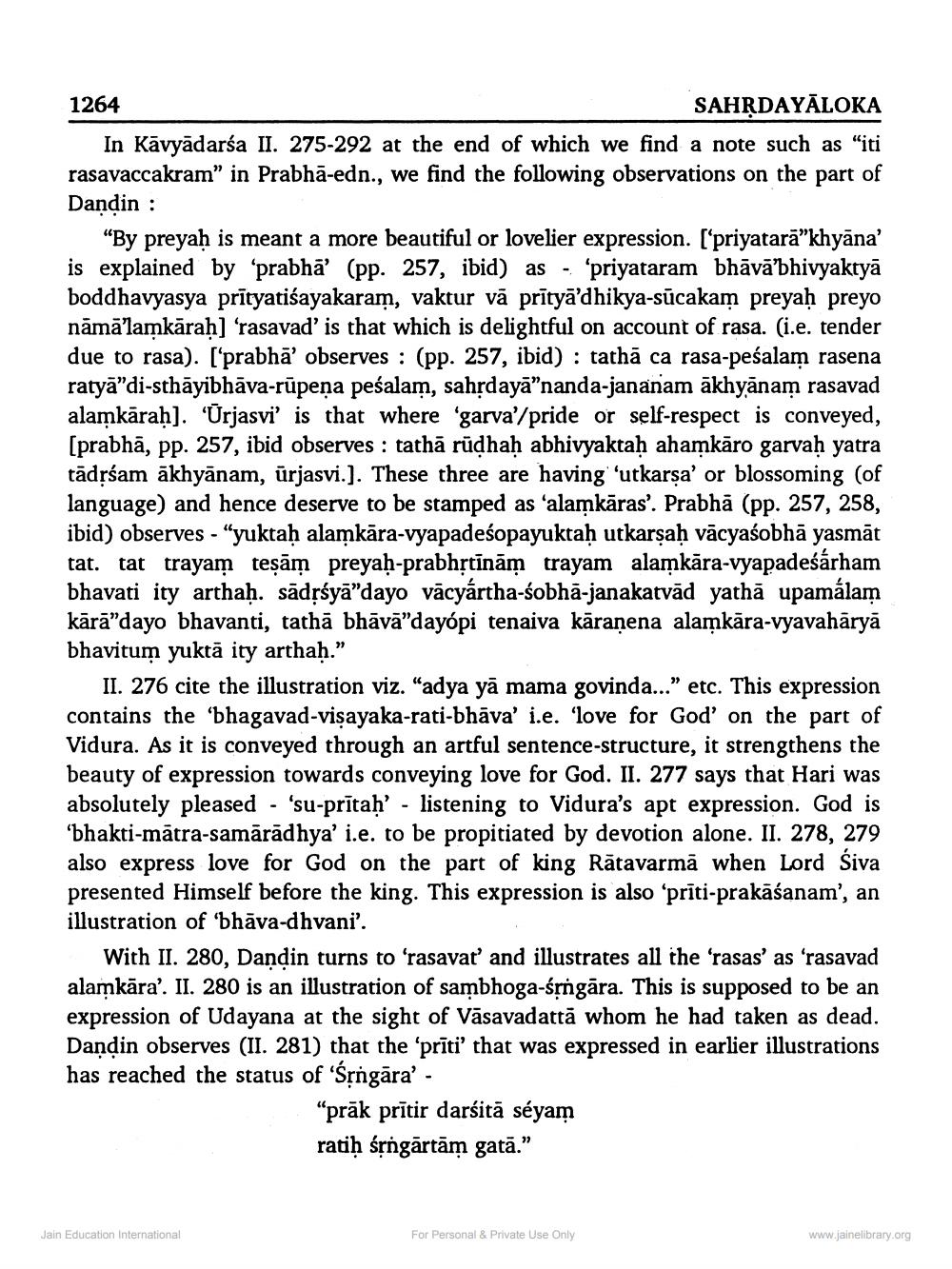________________
1264
SAHĶDAYĀLOKA In Kavyādarśa II. 275-292 at the end of which we find a note such as "iti rasavaccakram” in Prabhā-edn., we find the following observations on the part of Dandin :
“By preyah is meant a more beautiful or lovelier expression. ['priyatarā”khyāna' is explained by prabhā (pp. 257, ibid) as - 'priyataram bhāvā bhivyaktyā boddhavyasya prītyatiśayakaram, vaktur vă prītyā’dhikya-sūcakam preyaḥ preyo nāmā'lamkārah] 'rasavad' is that which is delightful on account of rasa. (i.e. tender due to rasa). ['prabhā' observes : (pp. 257, ibid): tathā ca rasa-peśalam rasena ratyā"di-sthāyibhāva-rūpena peśalam, sahrdayā”nanda-jananam ākhyānam rasavad alamkāraḥ). 'Urjasvi' is that where 'garva' pride or self-respect is conveyed, (prabhā, pp. 257, ibid observes : tathā rūdhah abhivyaktah ahamkāro garvah yatra tādṛśam ākhyānam, ürjasvi.). These three are having 'utkarsa' or blossoming (of language) and hence deserve to be stamped as ‘alamkāras'. Prabhā (pp. 257, 258, ibid) observes - "yuktaḥ alamkāra-vyapadeśopayuktaḥ utkarşaḥ vācyaśobhā yasmāt tat. tat trayam teşām preyah-prabhịtīnām trayam alamkāra-vyapadeśárham bhavati ity arthaḥ. sādřśyā”dayo vācyártha-śobhā-janakatvād yathā upamálam kārā”dayo bhavanti, tathā bhāvā”dayópi tenaiva kāraṇena alarmkāra-vyavahāryā bhavitum yuktā ity arthaḥ.”
II. 276 cite the illustration viz. “adya yā mama govinda..." etc. This expression contains the 'bhagavad-vişayaka-rati-bhāva' i.e. 'love for God' on the part of Vidura. As it is conveyed through an artful sentence-structure, it strengthens the beauty of expression towards conveying love for God. II. 277 says that Hari was absolutely pleased - 'su-prītah' - listening to Vidura's apt expression. God is 'bhakti-matra-samaradhya' i.e. to be propitiated by devotion alone. II. 278, 279 also express love for God on the part of king Rātavarmā when Lord Siva presented Himself before the king. This expression is also 'prīti-prakāśanam', an illustration of 'bhāva-dhvani'.
With II. 280, Dandin turns to 'rasavat' and illustrates all the 'rasas' as 'rasavad alamkāra'. II. 280 is an illustration of sambhoga-śrngāra. This is supposed to be an expression of Udayana at the sight of Vāsavadattā whom he had taken as dead. Dandin observes (II. 281) that the 'prīti' that was expressed in earlier illustrations has reached the status of 'Sțngāra'.
"prāk prītir darsitā séyam ratiḥ śộngārtām gatā."
Jain Education International
For Personal & Private Use Only
www.jainelibrary.org




